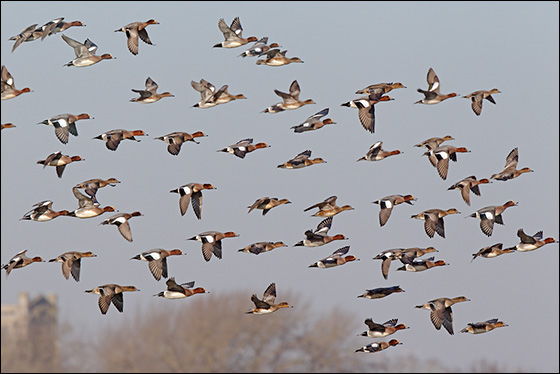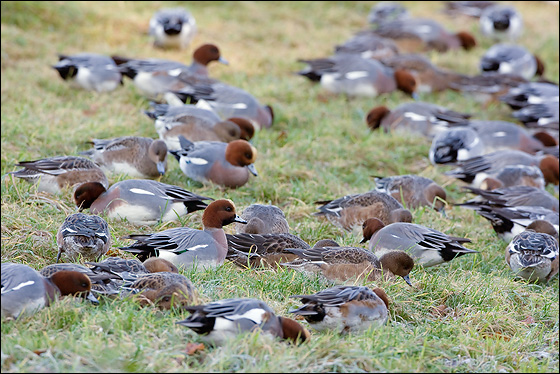Eurasian Wigeon (Anas penelope)
The Wigeon provides a good example of how a bird uses various features of its plumage in display. Look at a male Wigeon in flight, and you will be struck by its brilliant white forewing. On the water, when rivals want to threaten each other, they casually lift their folded wings high above their backs for a moment, showing off the white markings to full effect. If you see a male Wigeon on the water, it is hard to miss its straw-coloured forehead. Similarly, when the dominant male in a displaying group wishes to demonstrate its superiority off to a female, it faces her, raises the feathers on its forehead, and moves its bill slightly from side to side, exaggerating and showing off that choice feature. No other male ducks have similar plumage marks to the Wigeon, and no others perform these highly specific displays.
This attractively coloured duck belongs to a group known as the surface-feeding, or dabbling ducks, the ones that do not dive under the water to get their food. Each of the dabblers is ecologically distinct from the other, and the Wigeon is special by being the consummate grazer of the group, feeding not so much on the water but on the land, and eating grass, leaves, stems and roots. When foraging, Wigeons often gather in densely packed flocks, covering the grassy swards with their bodies, and spilling forward like an incoming tide. Each has the unusual combination of a small bill and an exceedingly strong jawbone, which enables them to pull up the grass with great vigour and make use of the bill’s cutting edge at the same time.
Sometimes Wigeons abandon their grazing habit for a short while and make use of other methods instead. They will quite readily swim on the water surface and dabble, and sometimes they up-end, although they perform this manoeuvre less often than most other ducks. Perhaps their most interesting secondary foraging method, though, is to be something of a pest to other birds. Quite a few other wildfowl share the Wigeon’s vegetarian diet, and Wigeons will, at times, feed off their scraps. Mute Swans, for example, can reach plant matter growing well down on the lake bed, and in the process of bringing a mouthful to the surface, they inevitably lose some from their grasp. To take advantage of this, Wigeons have been known to position themselves virtually under a swan’s neck ready to catch the spillage, and they sometimes do the same to White-fronted Geese. Coots, for their part, dive to get food, but they must come to the water surface to swallow it, so they, too, often find a Wigeon in close attendance upon rising.
This attractively coloured duck belongs to a group known as the surface-feeding, or dabbling ducks, the ones that do not dive under the water to get their food. Each of the dabblers is ecologically distinct from the other, and the Wigeon is special by being the consummate grazer of the group, feeding not so much on the water but on the land, and eating grass, leaves, stems and roots. When foraging, Wigeons often gather in densely packed flocks, covering the grassy swards with their bodies, and spilling forward like an incoming tide. Each has the unusual combination of a small bill and an exceedingly strong jawbone, which enables them to pull up the grass with great vigour and make use of the bill’s cutting edge at the same time.
Sometimes Wigeons abandon their grazing habit for a short while and make use of other methods instead. They will quite readily swim on the water surface and dabble, and sometimes they up-end, although they perform this manoeuvre less often than most other ducks. Perhaps their most interesting secondary foraging method, though, is to be something of a pest to other birds. Quite a few other wildfowl share the Wigeon’s vegetarian diet, and Wigeons will, at times, feed off their scraps. Mute Swans, for example, can reach plant matter growing well down on the lake bed, and in the process of bringing a mouthful to the surface, they inevitably lose some from their grasp. To take advantage of this, Wigeons have been known to position themselves virtually under a swan’s neck ready to catch the spillage, and they sometimes do the same to White-fronted Geese. Coots, for their part, dive to get food, but they must come to the water surface to swallow it, so they, too, often find a Wigeon in close attendance upon rising.
The Wigeon breeds only in northern Europe, although it is not closely attached to Arctic regions and avoids open tundra. In fact, it often nests in quite bushy habitats, so long as these are by lakes or marshes; and occasionally it will even select a site among trees. The nest is always on the ground, and very well concealed in low cover.
Few duck are as vocal, and memorably so, as the Wigeon. Throughout the pairing season in autumn and winter the males constantly utter an excited, almost surprised exclamatory whistle, while the females grunt approvingly.


